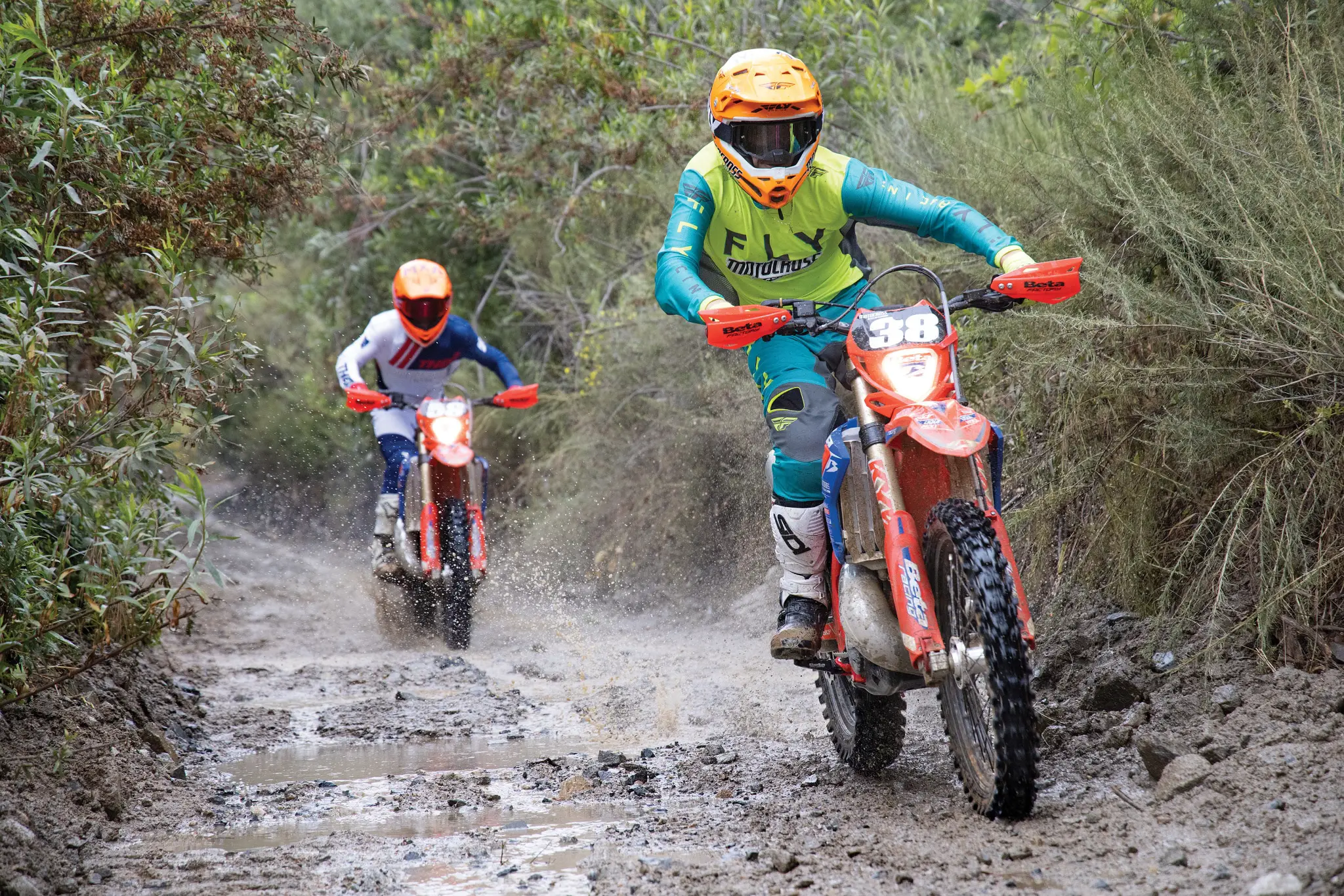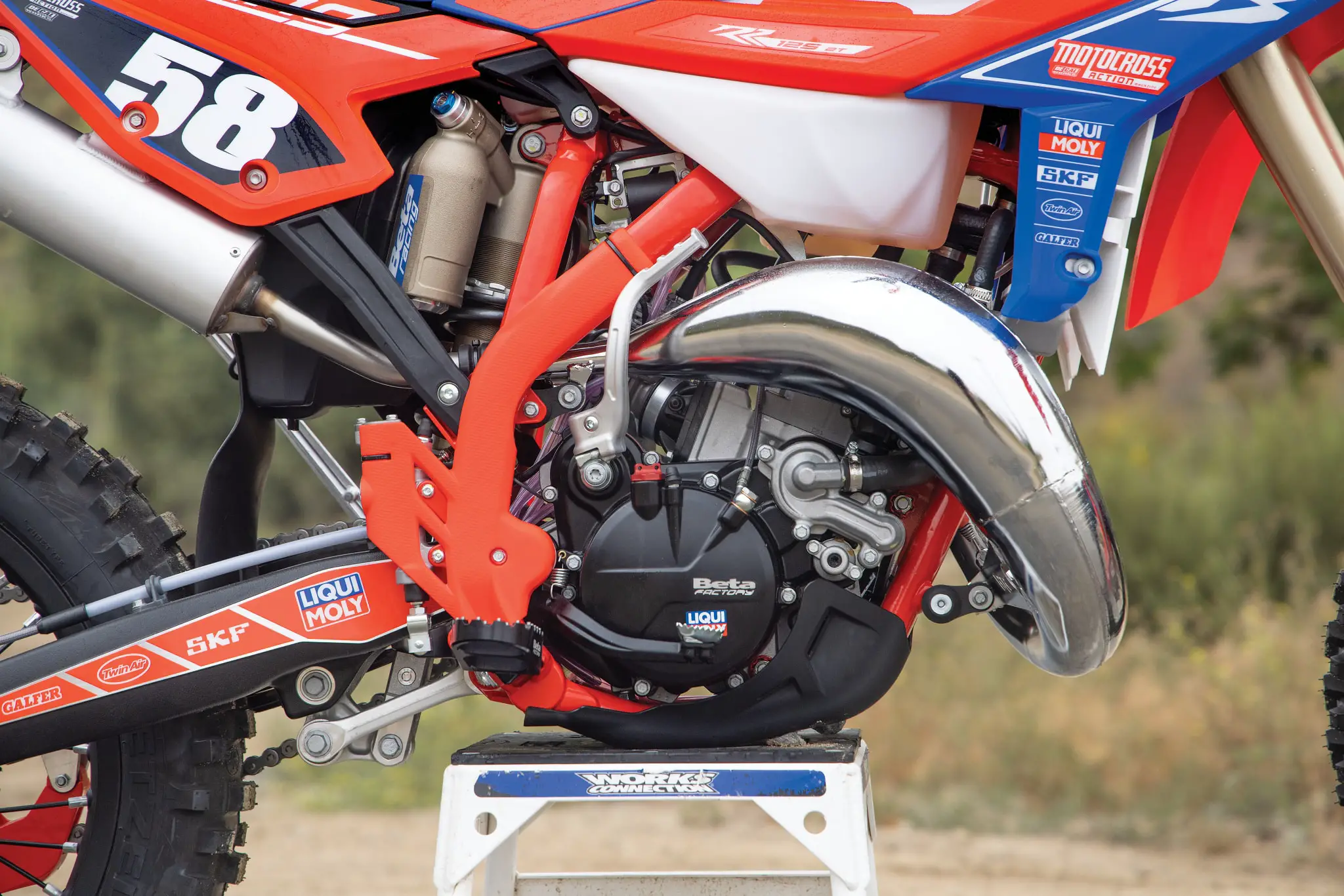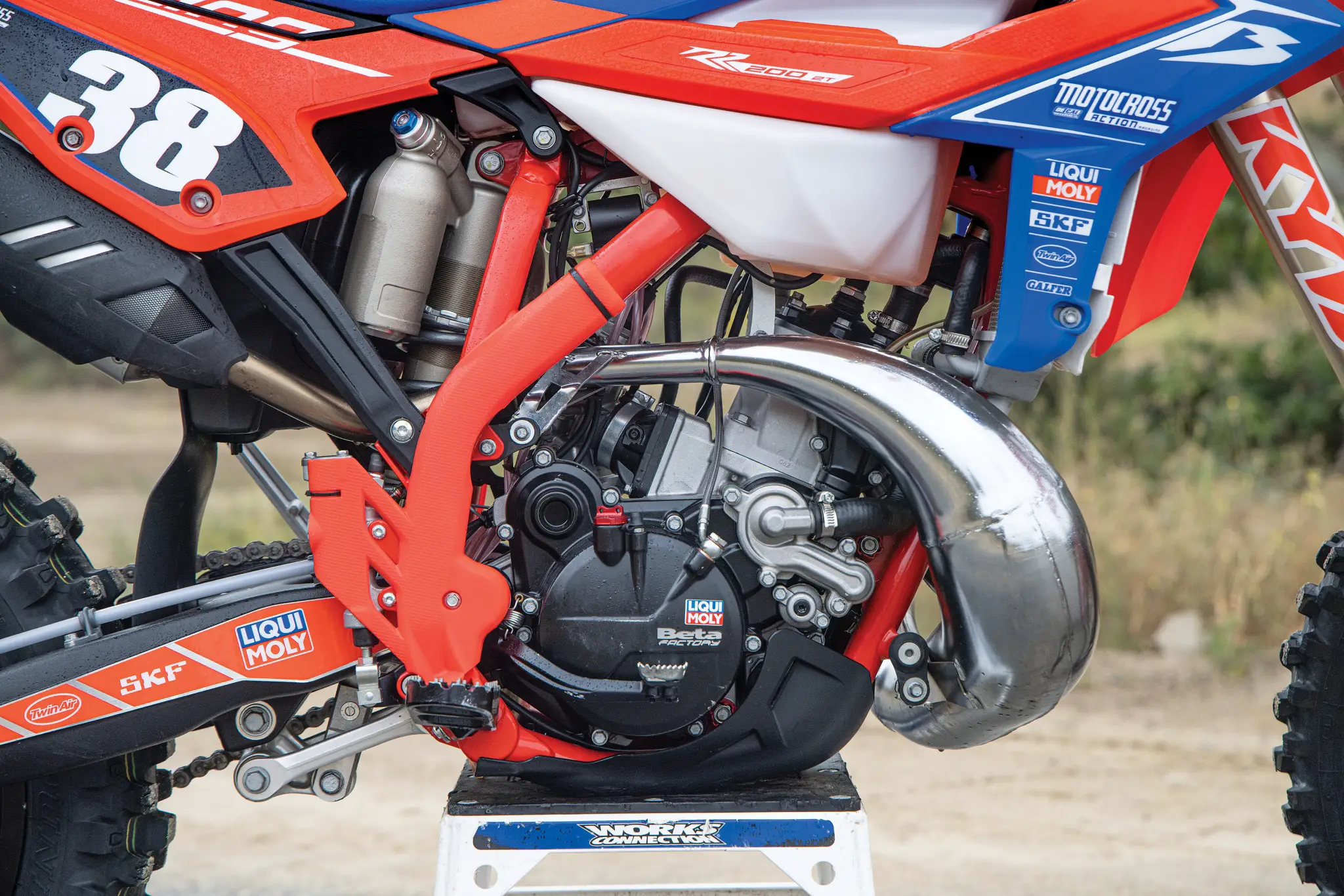MXA RACE TEST: THE REAL TEST OF THE 2023 BETA 200 VS BETA 125 RACE EDITIONS

Q: WHY IS MXA TESTING ENDURO BIKES?
A: We dabble in the off-road game here and there. A handful of our test riders race off-road consistently, while others do just a few off-road events throughout the year in between motocross races. One of the main reasons for this test is to further get to know the Beta brand as a whole, because they’ve recently committed to entering the motocross market. The 2021 Beta 300RX was the first motocross-specific bike that Beta has ever made, which is surprising considering that this Italian motorcycle manufacturer has been producing bikes since 1905. Originally, under the name “Societa Giuseppe Bianchi,” handmade bicycles were the first offering of this company, and then, in the late 1940s, the company switched gears to motorcycle production.
Q: HOW IS BETA GOING TO ENTER THE MOTOCROSS REALM?
A: For 2024, Beta is bringing their new 450RX four-stroke to market, and they’ll be racing it in the 2024 AMA Supercross with a two-rider factory Beta USA team. Beta has been race-testing prototype versions of the 450RX in the MXGP World Championship with Jeremy Van Horebeek in the 2021–’22 seasons, and Alessandro Lupino and Ben Watson in the 2023 season. Because the MXGP World Championship is a works-bike series, riders are allowed to race prototype motorcycles with different frames and engines than stock. Here in the States, the AMA series has a production rule, meaning that each bike must be homologized, and at least 400 units must be available for sale to the public for a bike to be raced. For this same reason, racers in America can’t compete with bikes older than five years old.
Beta has been using their MXGP riders as real-life race testers who are developing their new 450 motocross bike in race conditions, and we’re excited to test the Beta 450RX as soon as we can get our hands on it.

Q: WHO ARE THE BETA 125 AND 200RR RACE EDITION BIKES MADE FOR?
A: Because we are so accustomed to testing race bikes, it feels like an insult to say a bike is built for the average rider, but Beta USA actually takes pride in that statement and describes their RR Race Edition bikes in that way. For all of Beta’s off-road bikes, their slogan is “Rideability,” and they strive to build bikes that appeal to the common rider. With headlights, taillights, oversized tanks, 18-inch rear wheels and wide-ratio 6-speed transmissions, the Beta 125 and 200 are both made for enduro-style riding in the mountains and woods.
Q: WHAT DIFFERENTIATES THE STANDARD RR AND RR RACE EDITION MODELS?
A: Beta offers a wide variety of off-road bikes. They have 125, 200, 250 and 300 RR two-stroke models available in both standard and “Race Edition” versions. They have 350, 390, 430 and 480RR four-stroke models available in both RR and RR Race Edition models. Then, they have the 300RX motocross two-stroke and four dual-sport bikes, a bunch of different trials bikes, electric trials bikes for kids, electric balance bikes for kids, and they’re coming out with a Surron-style electric dirt bike for adults some time in 2024.
Here’s a list of the list of upgrades that set apart the RR Race Edition 125 and 200 models from the standard versions.
(1) Suspension. The stock models come with Sachs open-cartridge forks and a Sachs shock, while the Race Edition bikes come with Kayaba closed-cartridge forks and shocks. The Kayaba suspension also has slightly longer-travel front and rear.
(2) Pre-mix. The stock 200RR is oil-injected, but the 200RR Race Edition bike is not; it uses 50:1 pre-mix. However, both the stock and race edition 125 models use 50:1 pre-mixed fuel for lubrication in the engine.
(3) Aesthetics. The standard RR models are black and red, while the Race Editions are blue and red with a blue gripper seat cover to match the plastics.
(4) Accessories. The Race Edition models come with quick-release front axles, black-anodized alloy shift and brake levers, dual-material rear sprockets (with steel teeth and aluminum cores), and billet-aluminum footpegs.
(5) Tires. The RR version comes with Maxxis Enduro tires, while the RR Race Editions come with ISDE Metzler tires.
(6) Engine. The Race Edition 200 has a different cylinder head that ups the compression ratio from 13.65:1 to 14.4:1. It also has a single power-valve spring that is stiffer than the dual-power-valve spring on the standard RR model. The 125 Race Edition has the same engine setup as the standard bike.
(7) Protection. Both the standard and Race Edition bikes come with skid plates, but only the Race Editions come with handguards.
Q: HOW DID THE BETA 200 RACE EDITION MODEL RUN ON THE TRACK?
A: Of course, these are enduro bikes, but we had to take both of them on the track to open up the power and see what they’re made of. The initial impressions were that the 200RR felt like a heavily modified 125. It didn’t have the top-end power of a 250 two-stroke, but it had much more bottom end than a 125. Riding through corners and tighter sections, the bottom end was mellow and very user-friendly, especially for a two-stroke. When riding it hard and really getting on the gas for faster sections, the engine revved out quickly and needed to be short-shifted to keep driving forward. Unfortunately, it didn’t like to be shifted under a load, our testers had to make sure to pull in the clutch and chop the throttle slightly to shift to the next gear.
Luckily, our local stomping grounds (Glen Helen) has miles of off-road trails as well, and this bike was ultra-fun through the trees, rocky creek beds and winding, long hill-climbs. The torque easily pulled our test riders up steep hills and over rocks in the technical sections. It might not have the top end of a 250 or 300 two-stroke, but this bike attacked the rugged trails with ease.

Q: HOW DOES THE BETA 125RR RACE EDITION RUN ON THE TRACK?
A: After riding the 200RR, the 125RR Race Edition felt like it was lacking big time on bottom-end torque. But, on a track, the 125RR was able to carry gears longer than the 200, which was a plus for high-speed sections. On the off-road trails, we were missing the 200RR’s powerband big time. However, we were surprised by the 125RR’s throttle response and smooth, controllable power. Compared to a YZ125 or any carbureted Austrian 125, there’s usually more of a lag at the crack of the throttle, but the Beta surprisingly picks up and gets into the meat of the power easily.
To help get some more bottom-end snap, we recommend using the lightest power-valve spring and removing the inner auxiliary spring. This allows the exhaust port to open up sooner and helps the 125 get into the meat of the power faster. The power-valve setup is similar to the 2022 and prior-model KTM two-strokes. It’s located on the right side of the engine in front of the rear brake pedal. The Austrian bikes require a Robertson wrench to turn the power valve in or out, and the Beta setup is easier to adjust because it uses an Allen.
As for jetting, we were impressed with how clean both the 125 and 200 ran. We left the jetting stock and adjusted the air screw slightly. We also were impressed the 125RR or 200RR rarely loaded up. Compared to a 2022 KTM 125SX that we had to clean out quite often, the Beta ran crisp and clean, even at idle.

Q: HOW DID THE BETA 125RR AND 200RR MODELS RUN ON THE DYNO?
A: When we looked at the dyno chart comparing these two bikes, we thought the graphs had been flopped and weren’t lined up properly. The difference between the 125 and 200 couldn’t be any further apart.
125RR. The 125RR has a traditional 125 powerband that is similar to a YZ125. The Beta 125RR follows just behind the YZ125 power curve up until 9000 rpm when the YZ125 continues to climb and the Beta begins to dip. The Beta is at 27.5 horsepower at 10,000 rpm, while the YZ is at 30 horsepower and the Austrian 125 two-strokes are at 32 horsepower. At 10,500 rpm, the Beta power curve ramps back up to an impressive 35 horsepower, while the YZ125 hits 35.7 horsepower at 11,700 rpm and the GasGas hits 38.25 horsepower at 11,400 rpm.
200RR. The 200RR Race Edition’s dyno curve is the complete opposite of the 125RR. Where the 125 was all top and no bottom, the 200 is all bottom and no top. The 200RR is actually lower on peak power than the 125, but it doesn’t feel like it on the track. The 200RR starts out at 20 horsepower at 6000 rpm, while the 125 is at 11 horsepower, see the difference? The 200 RR hits 25 horses at 7000 rpm, while the 125 is just under 15. The 200RR hits 30 horsepower at 8000 rpm, while the 125 is making 20. Then, the 200RR tops out at 9200 rpm with 33.23 horsepower, while the 125 climbs to 11,200 where it peaks out an extra 1-1/2-horse stronger than the 200. Wild, right?
While trying to dissect the Beta dyno charts, Pro Circuit’s ace mechanic, Mike “Schnikey” Tomlin, pointed out how obvious the dyno results were just by looking at the exhaust pipes. The 200RR exhaust pipe was big and long; it’s built like a pipe you’d find on a 300cc smoker. While the 125 pipe is the traditional shape you’d find on a tiddler, it’s short and snappy, giving up low-end but allowing it to rev further and peak later.
Q: HOW DID THE BETA 125 AND 200 MODELS HANDLE?
A: Both the 125RR and 200RR Race Editions handled great. Obviously, the suspension was soft, as it’s intended for enduro riding. Still, the Kayaba setup was pleasant, even on the track. The Kayaba forks offer 11.8 inches of travel, compared to the 11.6 inches of the previous Sachs forks. The Kayaba shock offers 12.4 inches of travel compared to 11.4 inches on the Sachs rear shock. We had vet test riders race these bikes on the Glen Helen’s Arroyo track, and they were impressed with how balanced the bikes felt. They appreciated how nimble the Betas were in the corners.
On the trails, the Betas shined. They were made for roots, rocks, ruts and creek beds. Although they are weighed down by oversized gas tanks, headlights, taillights, speedometer and an electric starter (on the 200 only), these bikes still felt light and nimble in motion. Our test riders could easily put the wheels where they wanted them, and the Brembo clutch made for a consistent and strong hook-up when it came time to pop a wheelie over rocks and logs.
Q: WHAT DID WE REALLY THINK?
A: The Beta 125RR and 200RR Race Edition two-strokes were a lot of fun. Beta’s slogan, “Rideability,” rang true for our test riders. When we think of the American 125 two-stroke market, we think of experienced riders wringing the little engines out, slipping the clutch and laying it over the berms. However, the Beta 125RR Race Edition has a sweet powerband that picked up quickly and was more friendly to ride on tight trails than a Yamaha YZ, KTM 125SX, Husqvarna TC125 or GasGas MC125. The Beta small-bore two-strokes create new opportunities for novice-level riders who’d normally struggle on a 125. Of course, if you’re riding on the track or if you’re riding West Coast-style, high-speed Grand Prix off-road races in the desert, you’ll want a YZ, SX, TC or MC for their stronger top end.
The 200RR Race Edition rode like a 125 with serious torque. It is the perfect woods bike for experienced riders looking to work on their technical skills, or for novice-level riders who aren’t focused on racing in the 125cc class and who understand that they don’t need all the power of a 250 or 300cc two-stroke.
Overall, our test riders preferred the Beta 200RR Race Edition over the 125 for its low-end grunt. Of course, this isn’t a fair competition, with one bike having a 75cc displacement advantage, but there has to be a winner, right?









Comments are closed.